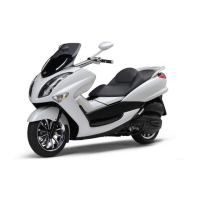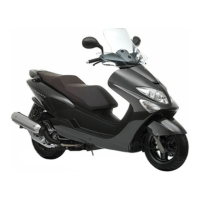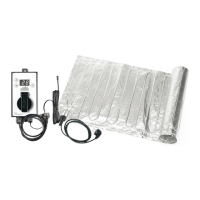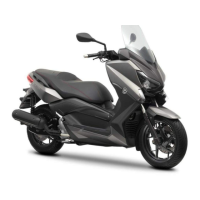Do you have a question about the Yamaha Majesty YP400W and is the answer not in the manual?
Advice on pre-operation checks, visibility, intersections, and avoiding blind spots.
Importance of helmets, protective clothing to prevent injuries.
Guidelines for adding cargo/accessories to maintain stability and avoid accidents.
Precautions regarding gasoline flammability and exhaust fumes.
Tips on signaling, braking on wet surfaces, cornering, and road hazards.
Identifies and explains the function of the scooter's controls and dashboard instruments.
Explains the function and positions of the main switch and steering lock.
Describes the function of various indicator and warning lights on the dashboard.
Explains how to read the speedometer and its self-test function.
Explains the tachometer, its red zone, and self-test function.
Details the various functions and indicators on the multi-function display.
Identifies and explains the function of switches on the left handlebar.
Identifies and explains switches on the right handlebar, including start and engine stop.
Explains how to operate the front brake lever.
Explains how to operate the rear brake lever.
Explains how to use the rear brake lock lever and its safety warning.
Advice on recommended fuel type, capacity, and precautions during refueling.
Specifies the maximum load for front and rear storage compartments.
Explains sidestand operation and its role in the ignition cut-off system.
Describes the functions of the ignition circuit cut-off system.
Lists essential checks before riding, including fuel, engine oil, brakes, and tires.
Instructions for checking wheels and tires for damage, tread depth, and pressure.
Step-by-step instructions for starting the engine, including safety checks.
Procedures for safely moving the scooter off the centerstand and beginning to ride.
How to adjust speed using the throttle grip.
How to apply front and rear brakes simultaneously for effective stopping.
Guidelines for the initial break-in period to ensure engine longevity.
Instructions on how to park the scooter safely, considering hot components and ground conditions.
Chart detailing periodic checks and replacements for emission control components.
Chart outlining routine checks, lubrication, and replacements for various parts.
Procedure for changing engine oil and checking oil level.
Procedure for replacing the engine oil filter element.
Procedure for removing and checking the spark plug condition.
Instructions for checking the engine oil level using the dipstick.
Instructions for checking the coolant level in the reservoir.
Steps to remove and replace air filter elements.
Importance of checking and adjusting tire air pressure before each ride.
Steps to replace blown fuses and locate the fuse box.
Introduction to troubleshooting common issues and using genuine parts.
Flowcharts for diagnosing starting problems related to fuel, compression, ignition, and battery.
Procedure for diagnosing engine overheating, checking coolant level and leakage.
Recommended tire air pressure for different loading conditions.
| Engine Displacement | 395cc |
|---|---|
| Fuel System | Fuel injection |
| Front Suspension | Telescopic fork |
| Front Tire | 120/70-14 |
| Rear Tire | 150/70-13 |
| Bore x Stroke | 83.0 mm x 73.0 mm |
| Starter | Electric |
| Rear Suspension Type | Unit Swing |
| Transmission Type | Automatic V-belt |
| Length | 2, 230mm |
| Torque | 36.0 Nm @ 6, 000 rpm |











